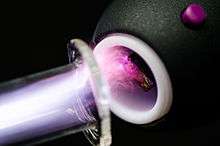Piezoelectric direct discharge plasma
Piezoelectric direct discharge is a type of a cold (nonequilibrium) plasma generation method that can efficiently ionize different process gases including air in a wide pressure range.
Background
The majority of industrial plasma processing is conducted with glow discharges at pressures below 10 torr. It has long been recognized that glow discharges would play a much larger industrial role if they could be generated at normal pressure, and in ambient air. In this context the Paschen’s law describes the physical limits of plasma ignition depending on pressure and electrode gap.
For atmospheric plasma sources used in technology, low frequency and DC power supplies are always connected with high current electric arcs and the formation of thermal equilibrium plasma where the temperature is relatively homogeneous throughout the atoms, molecules, ions and electrons and can quickly exceed several thousand Kelvin.
Nonequilibrium plasma (cold plasma) can be generated under atmospheric conditions at very high frequencies or using short duration microdischarges created by dielectric breakdown between two electrodes separated by an insulating dielectric barrier. The so-called “cold discharge” or dielectric barrier discharge (DBD) is used in many applications where high temperatures have to be avoided.
Principle of piezoelectric direct discharge (PDD)
The basic concept of the piezoelectric direct discharge technology (PDD) is to use a piezoelectric transformer (PT) as an integral part of the plasma source. Thus, all high voltage problems of traditional atmospheric plasma sources can be avoided. Both plasma microjets and surface discharge plasma devices of the corona type can be built.
Technology
Piezoelectric transformers made of PZT electroceramics generate high voltage, by electro-mechanical energy conversion based on the piezoelectric effect. The oscillating surface potential can cause excitation and ionization of atoms and molecules resulting in the generation of piezoelectric direct discharge plasma (PDD). The discharge structure shows the characteristic filament micro pattern of short duration (microseconds and below) typical for dielectric barrier discharges (DBD). PDD is applicable for ozone generation, excimer lamps, chemical microreactors and surface treatment.
The basic concept of the piezoelectric direct discharge technology (PDD) is to use a piezoelectric transformer (PT) as an integral part of the plasma source.[1][2] Thus, all high voltage problems of traditional atmospheric plasma sources can be avoided. Both plasma microjets and surface discharge plasma devices of the corona type can be built.
Piezoelectric transformers (PTs) generate high electric fields due to the piezoelectric effect. At the tip of the PT, the high field gradients cause strong polarization, excitation and ionization of atoms and molecules. This generates piezoelectric direct discharge plasma (PDD plasma) with properties also found for dielectric barrier discharges (DBD) or corona discharges.

PTs of the Rosen type[3][4] offer high power density and very high voltage conversion factors of > 1000. They are electromechanical devices with high figures of merit and resonance frequencies between typically 10 kHz and more than 500 kHz. If the driving circuit is matched to the resonance frequency and the impedance of the PT, the conversion of primary power to discharge energy is very good. Power signal behavior of the system will differ strongly from small signal behavior. At the threshold of discharge, the damping factor will rise and resonance frequency will shift. To stabilize the PDD, frequency tracking is recommended.
Application
Ozone generators using a PDD operated with air were found to generate a medium ozone concentration, but exhibit the highest efficiency among ozone generators operated at room temperature.
Using optical emission spectroscopy, gas temperatures in the active plasma volume have been found to be near ambient 300 + 20 K. Electron densities in the order of 10−14-10−16 m−3 in the active plasma volume can be achieved. PDD is a typical nonthermal (cold) plasma effect. PDD plasma can be induced in many different process gases such as Argon, Helium, nitrogen and air. Using He/Xe mixtures, PDD yields VUV radiation (peaking at 172 nm, Xe* excimer).[5]
These properties of PDD open up many fields of application in medical technology, microbiology and clinical research.[6] The most typical industrial application of PDD based jets is surface activation, which optimizes wetting properties and material adhesion.[7] The high efficiency of the process and the compactness of the device allow designing slim handheld PDD tools.
References
- ↑ M. Teschke and J. Engemann, Contrib. Plasma Phys. 49, 614 (2009)
- ↑ M. Teschke and J. Engemann, US020090122941A1, U.S. Patent application
- ↑ C.A. Rosen, K.A. Fish, H.C.Rothenberg, U.S. Patent No. 2,830,374 (April 1958)
- ↑ C.A.Rosen, in Solid State Magnetic and Dielectric Devices, edited by H. W. Katz (John Wiley & Sons, Inc., London, 1959) pp. 170-197
- ↑ K. Teranishi, H. Itoh in Journal of Light & Visual Environment 01/2007; 31(1):5-10
- ↑ A. Fridman, G. Friedman, "Plasma Medicine", Wiley; 1 edition (February 11, 2013)
- ↑ M. A. Lieberman, Al. J. Lichtenberg "Principles of Plasma Discharges and Materials Processing", Wiley-Interscience; 2 edition (April 14, 2005)